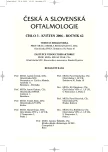-
Medical journals
- Career
Sympathetic Ophthalmia
Authors: P. Svozílková; E. Říhová; M. Brichová; J. Plšková; D. Jeníčková; B. Kalvodová
Authors‘ workplace: Oční klinika VFN a 1. LF UK, Praha přednosta doc. MUDr. B. Kalvodová, CSc.
Published in: Čes. a slov. Oftal., 62, 2006, No. 3, p. 218-223
Overview
Purpose:
to evaluate the efficacy of treatment on prevention of disease development and protection of visual outcomes in patients suffering from sympathetic ophthalmia.Methods:
retrospective case.Results:
four patients with sympathetic ophthalmia were treated in our department from 1999 to 2004. All patients were men with the mean age 27.5 years (15-49 years). In two patients, there was a history of penetrating eye injury prior to the onset of sympathetic ophthalmia, in other two patients sympathetic ophthalmia occurred after eye surgery (pars plana vitrectomy), with no previous ocular trauma. Two patients were treated with monotherapy of corticosteroids; other two patients were commenced on combined immunosuppression. In all these cases, the therapy was effective.Conclusion:
sympathetic ophthalmia is a rare, sight-threatening eye disease. Among the triggering factors dominates penetrating eye injury, however, there is currently an increase in the number of cases with sympathetic ophthalmia following eye surgery, mainly pars plana vitrectomy. Early introduction of immunosuppressive treatment can get the disease under control, prevent the development of intraocular inflammation and improve visual outcomes.Key words:
sympathetic ophthalmia, immunosuppressive therapy, pars plana vitrectomy, penetrating eye injury
Labels
Ophthalmology
Article was published inCzech and Slovak Ophthalmology

2006 Issue 3-
All articles in this issue
- Delivery of the Gentamicin to the Eye via Iontophoresis
- Visual Functions’ Detailed Evaluating in Patients with Sjögren’s Syndrome before and after Intracanalicular Implants’ (Smart Plug) Insertion – (First Results)
- Transpupillary Thermotherapy in the Treatment of Choroidal New Vessels in Age-Related Macular Degeneration – One Year’s Results
- The Intravitreal Application of Triamcinolone in the Treatment of the Macular Edema
- Effect of Lasik on Objective and Subjective Visual Functions in Patients with Myopia
- Sympathetic Ophthalmia
- Macular Area with the Glaucoma Patients
- Czech and Slovak Ophthalmology
- Journal archive
- Current issue
- Online only
- About the journal
Most read in this issue- Sympathetic Ophthalmia
- The Intravitreal Application of Triamcinolone in the Treatment of the Macular Edema
- Transpupillary Thermotherapy in the Treatment of Choroidal New Vessels in Age-Related Macular Degeneration – One Year’s Results
- Macular Area with the Glaucoma Patients
Login#ADS_BOTTOM_SCRIPTS#Forgotten passwordEnter the email address that you registered with. We will send you instructions on how to set a new password.
- Career

